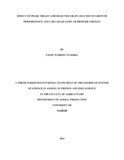| dc.description.abstract | The increasing cost of feed in broiler chicken production has compelled nutritionists to look for alternative sources of energy and protein. Two experiments in this study were carried out to determine the effect of replacing maize with pearl millet (PM) and including varying (0, 10, 20, and 30% ) levels of green grams (GG), cowpeas (CWP) and Lablab beans (LB) respectively in PM-soybean meal (SBM) based diets on growth performance and carcass quality of broiler chicken. The diets were isocaloric at 3000kcal/ kg of metabolizable energy (ME) for both the starter and finisher periods and isonitrogenous with a crude protein content of 22 and 20% for the starter and finisher diets respectively. A total of 80 and 400 male sexed Arbor Acres broilers were used in experiment one and two respectively. Broilers were reared for 42 days in both experiments and normal management procedures such as feeding, watering and disease control were conducted. Data on feed intake, body weight gain, Feed Conversion Ratio (FCR) as well as dressed weight, weight of breast muscle, drumstick, abdominal fat pad, gizzard, liver and pancreas were collected and analyzed. Results showed that, chicken fed on PM based diets had higher (P<0.05) weight gain than those fed on maize based diets. However, there was no significant effect on feed intake, FCR and all the carcass parameters investigated for the two diets. Results of experiment 2 showed that inclusion of GG in broiler chicken diets at levels of 10, 20 and 30% had no effect (P>0.05) on body weight gain, feed efficiency and all carcass parts studied. However, its inclusion above 20% level caused a significant reduction in feed intake. Inclusion of CWP at 10, 20 and 30% level had no effect (P>0.05) on feed intake, feed efficiency and all carcass parts studied. However, its inclusion above 10% level resulted in a reduction (P<0.05) in body weight gain. Inclusion of LB at all levels resulted in a significant reduction in feed intake, body weight gain and feed efficiency but it had no effect (P>0.05) on the weights of the carcass parts. The results also indicated that GG fed broilers had a better performance in
terms of body weight gain, live weight, dressed weight and drumstick weight followed by CWP while those on the LB diets had the least performance. It was also noted that broilers on all diets based on GG had a distinct yellow coloration of the shanks, skin and beaks. Color is important for visual appeal and consumers in Kenya prefer broilers with yellow skins similar to the indigenous chicken. Higher profit (Ksh 26.46/bird) was realized from chicken on PM compared to those fed on maize based diets in experiment one. Broilers in the 10% CWP diets had a higher net profit (4.8Ksh/bird) compared to the broilers on the 0%LGM diet. The high cost of GG and LB however, caused the feeds to be expensive resulting in lower profits than those on the 0%LGM diet. Therefore PM can be used to replace maize in broiler chicken diets resulting in higher body weight gain and profit. Green gram can be used in diets of broiler chicken at a level of 30% and CWP at a level of 10% without negatively affecting performance. However use of LB in broiler chicken diets should be discouraged as it reduces performance. | en_US |



